- SPRO Dashboard
- Financials
- Filings
-
Holdings
- Transcripts
- ETFs
- Insider
- Institutional
- Shorts
-
8-K Filing
Spero Therapeutics (SPRO) 8-KCorporate Presentation January 2025
Filed: 10 Jan 25, 7:00am
Exhibit 99.1
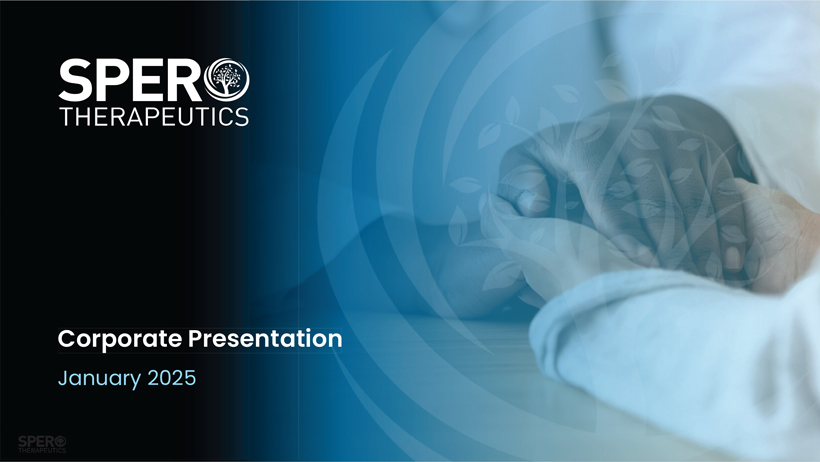
Corporate Presentation January 2025
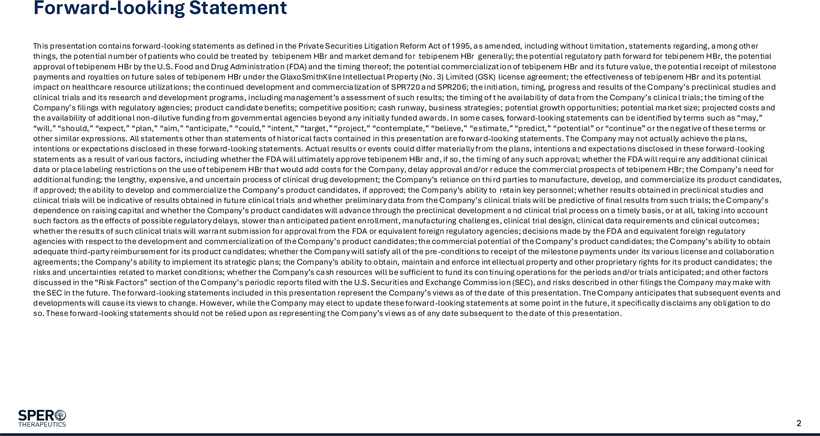
Forward-looking Statement This presentation contains forward-looking statements as defined in the Private Securities Litigation Reform Act of 1995, as amended, including without limitation, statements regarding, among other things, the potential number of patients who could be treated by tebipenem HBr and market demand for tebipenem HBr generally; the potential regulatory path forward for tebipenem HBr, the potential approval of tebipenem HBr by the U.S. Food and Drug Administration (FDA) and the timing thereof; the potential commercialization of tebipenem HBr and its future value, the potential receipt of milestone payments and royalties on future sales of tebipenem HBr under the GlaxoSmithKline Intellectual Property (No. 3) Limited (GSK) license agreement; the effectiveness of tebipenem HBr and its potential impact on healthcare resource utilizations; the continued development and commercialization of SPR720 and SPR206; the initiation, timing, progress and results of the Company’s preclinical studies and clinical trials and its research and development programs, including management’s assessment of such results; the timing of t he availability of data from the Company’s clinical trials; the timing of the Company’s filings with regulatory agencies; product candidate benefits; competitive position; cash runway, business strategies; potential growth opportunities; potential market size; projected costs and the availability of additional non-dilutive funding from governmental agencies beyond any initially funded awards. In some cases, forward-looking statements can be identified by terms such as “may,” “will,” “should,” “expect,” “plan,” “aim,” “anticipate,” “could,” “intent,” “target,” “project,” “contemplate,” “believe,” “estimate,” “predict,” “potential” or “continue” or the negative of these terms or other similar expressions. All statements other than statements of historical facts contained in this presentation are forward-looking statements. The Company may not actually achieve the plans, intentions or expectations disclosed in these forward-looking statements. Actual results or events could differ materially from the plans, intentions and expectations disclosed in these forward-looking statements as a result of various factors, including whether the FDA will ultimately approve tebipenem HBr and, if so, the timing of any such approval; whether the FDA will require any additional clinical data or place labeling restrictions on the use of tebipenem HBr that would add costs for the Company, delay approval and/or r educe the commercial prospects of tebipenem HBr; the Company’s need for additional funding; the lengthy, expensive, and uncertain process of clinical drug development; the Company’s reliance on third parties to manufacture, develop, and commercialize its product candidates, if approved; the ability to develop and commercialize the Company’s product candidates, if approved; the Company’s ability to retain key personnel; whether results obtained in preclinical studies and clinical trials will be indicative of results obtained in future clinical trials and whether preliminary data from the Company’s clinical trials will be predictive of final results from such trials; the Company’s dependence on raising capital and whether the Company’s product candidates will advance through the preclinical development a nd clinical trial process on a timely basis, or at all, taking into account such factors as the effects of possible regulatory delays, slower than anticipated patient enrollment, manufacturing challeng es, clinical trial design, clinical data requirements and clinical outcomes; whether the results of such clinical trials will warrant submission for approval from the FDA or equivalent foreign regulatory agencies; decisions made by the FDA and equivalent foreign regulatory agencies with respect to the development and commercialization of the Company’s product candidates; the commercial potential of the Company’s product candidates; the Company’s ability to obtain adequate third-party reimbursement for its product candidates; whether the Company will satisfy all of the pre-conditions to receipt of the milestone payments under its various license and collaboration agreements; the Company’s ability to implement its strategic plans; the Company’s ability to obtain, maintain and enforce int ellectual property and other proprietary rights for its product candidates; the risks and uncertainties related to market conditions; whether the Company’s cash resources will be sufficient to fund its con tinuing operations for the periods and/or trials anticipated; and other factors discussed in the “Risk Factors” section of the Company’s periodic reports filed with the U.S. Securities and Exchange Commiss ion (SEC), and risks described in other filings the Company may make with the SEC in the future. The forward-looking statements included in this presentation represent the Company’s views as of the date of this presentation. The Company anticipates that subsequent events and developments will cause its views to change. However, while the Company may elect to update these forward-looking statements at some point in the future, it specifically disclaims any obligation to do so. These forward-looking statements should not be relied upon as representing the Company’s views as of any date subsequent to the date of this presentation.
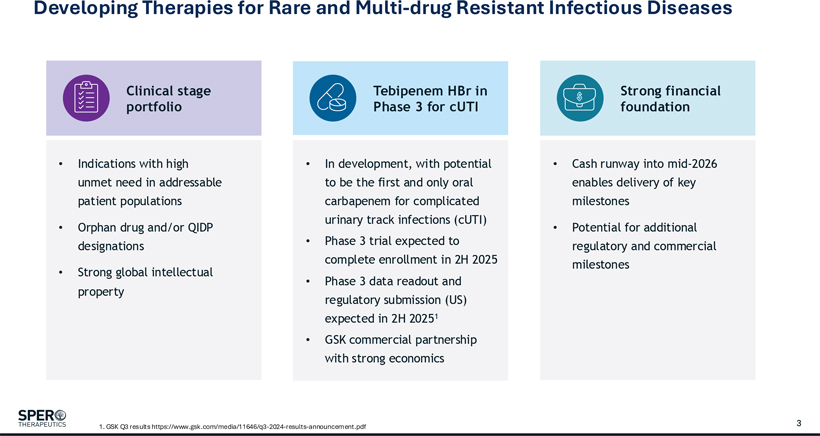
Developing Therapies for Rare and Multi-drug Resistant Infectious Diseases Clinical stage Tebipenem HBr in Strong financial portfolio Phase 3 for cUTI foundation • Indications with high • In development, with potential • Cash runway into mid-2026 unmet need in addressable to be the first and only oral enables delivery of key patient populations carbapenem for complicated milestones urinary track infections (cUTI) • Orphan drug and/or QIDP • Potential for additional designations • Phase 3 trial expected to regulatory and commercial complete enrollment in 2H 2025 milestones • Strong global intellectual • Phase 3 data readout and property regulatory submission (US) expected in 2H 20251 • GSK commercial partnership with strong economics
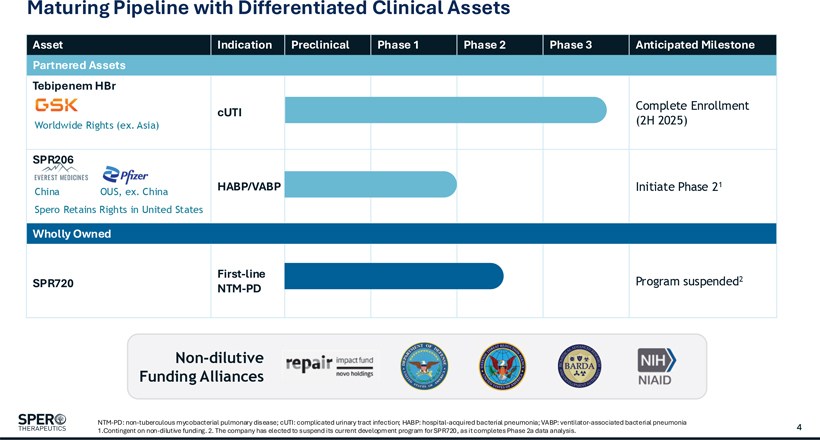
Maturing Pipeline with Differentiated Clinical Assets Asset Indication Preclinical Phase 1 Phase 2 Phase 3 Anticipated Milestone Partnered Assets Tebipenem HBr Complete Enrollment cUTI Worldwide Rights (ex. Asia) (2H 2025) SPR206 HABP/VABP Initiate Phase 21 China OUS, ex. China Spero Retains Rights in United States Wholly Owned First-line SPR720 Program suspended2 NTM-PD Non-dilutive Funding Alliances NTM-PD: non-tuberculous mycobacterial pulmonary disease; cUTI: complicated urinary tract infection; HABP: hospital-acquired bacterial pneumonia; VABP: ventilator-associated bacterial pneumonia 1.Contingent on non-dilutive funding. 2. The company has elected to suspend its current development program for SPR720, as it completes Phase 2a data analysis. 4
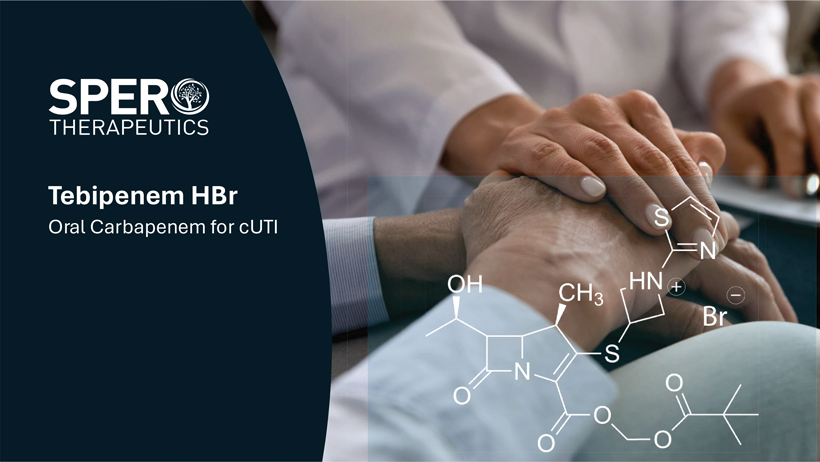
Tebipenem HBr Oral Carbapenem for cUTI
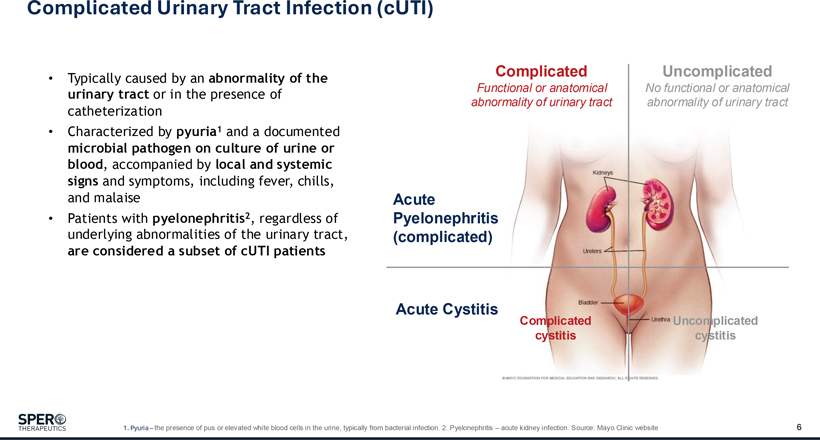
Complicated Urinary Tract Infection (cUTI) Typically caused by an abnormality of the Complicated Uncomplicated • urinary tract or in the presence of Functional or anatomical No functional or anatomical abnormality of urinary tract abnormality of urinary tract catheterization • Characterized by pyuria1 and a documented microbial pathogen on culture of urine or blood, accompanied by local and systemic signs and symptoms, including fever, chills, and malaise Acute • Patients with pyelonephritis2, regardless of Pyelonephritis underlying abnormalities of the urinary tract, (complicated) are considered a subset of cUTI patients Acute Cystitis Complicated Uncomplicated cystitis cystitis
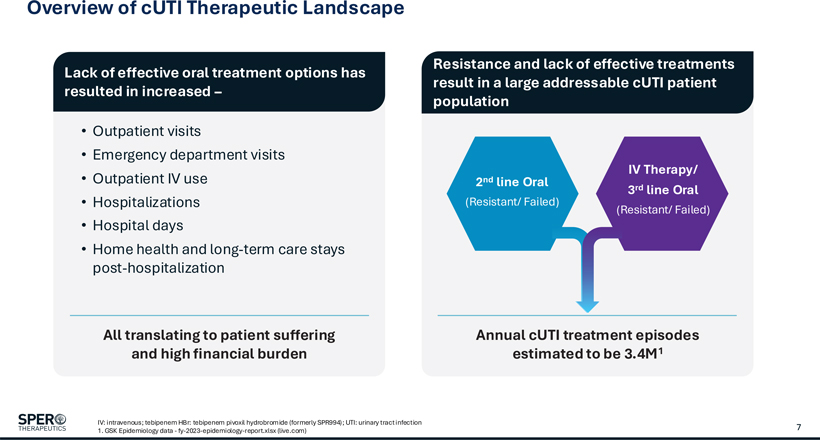
Overview of cUTI Therapeutic Landscape Resistance and lack of effective treatments Lack of effective oral treatment options has result in a large addressable cUTI patient resulted in increased –population • Outpatient visits • Emergency department visits nd IV Therapy/ • Outpatient IV use 2 line Oral 3rd line Oral • Hospitalizations (Resistant/ Failed) (Resistant/ Failed) • Hospital days • Home health and long-term care stays post-hospitalization All translating to patient suffering Annual cUTI treatment episodes and high financial burden estimated to be 3.4M1
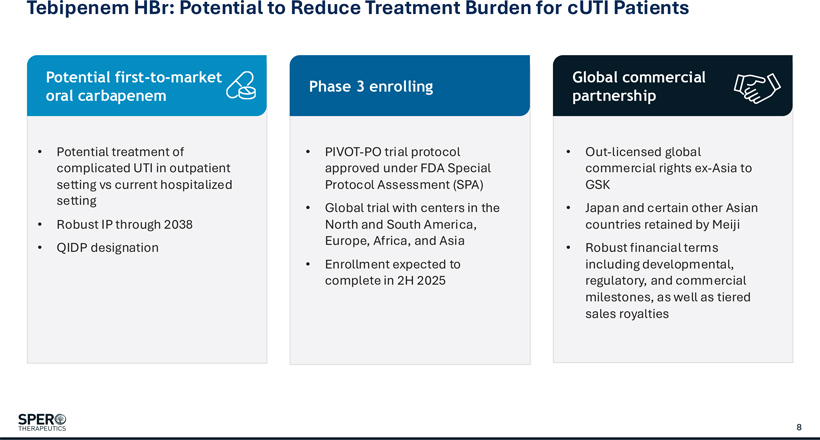
Tebipenem HBr: Potential to Reduce Treatment Burden for cUTI Patients Potential first-to-market Global commercial Phase 3 enrolling oral carbapenem partnership • Potential treatment of • PIVOT-PO trial protocol • Out-licensed global complicated UTI in outpatient approved under FDA Special commercial rights ex-Asia to setting vs current hospitalized Protocol Assessment (SPA) GSK setting • Global trial with centers in the • Japan and certain other Asian • Robust IP through 2038 North and South America, countries retained by Meiji Europe, Africa, and Asia • QIDP designation • Robust financial terms • Enrollment expected to including developmental, complete in 2H 2025 regulatory, and commercial milestones, as well as tiered sales royalties
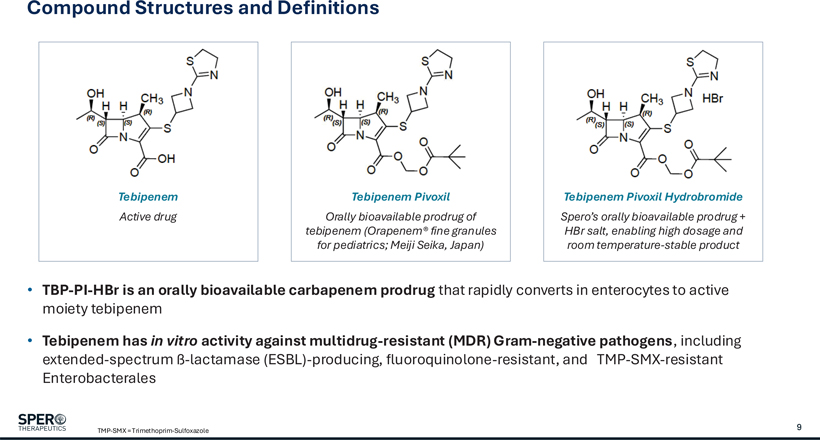
Compound Structures and Definitions Tebipenem Tebipenem Pivoxil Tebipenem Pivoxil Hydrobromide Active drug Orally bioavailable prodrug of Spero’s orally bioavailable prodrug + tebipenem (Orapenem® fine granules HBr salt, enabling high dosage and for pediatrics; Meiji Seika, Japan) room temperature-stable product • TBP-PI-HBr is an orally bioavailable carbapenem prodrug that rapidly converts in enterocytes to active moiety tebipenem • Tebipenem has in vitro activity against multidrug-resistant (MDR) Gram-negative pathogens, including extended-spectrum ß-lactamase (ESBL)-producing, fluoroquinolone-resistant, and TMP-SMX-resistant Enterobacterales
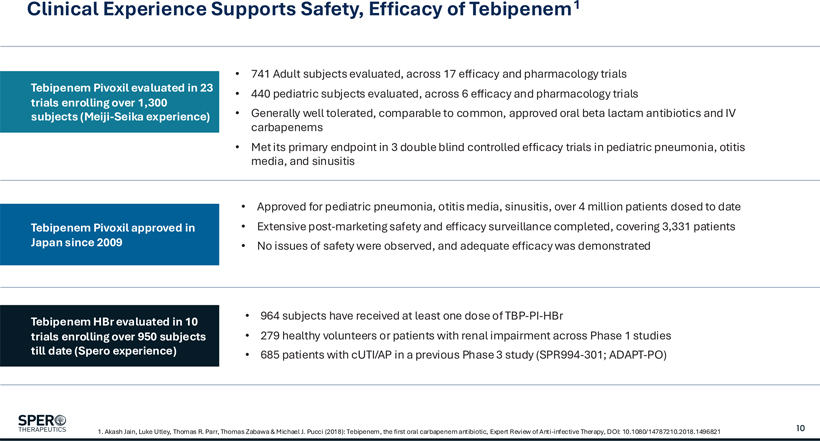
Clinical Experience Supports Safety, Efficacy of Tebipenem1 • 741 Adult subjects evaluated, across 17 efficacy and pharmacology trials Tebipenem Pivoxil evaluated in 23 • 440 pediatric subjects evaluated, across 6 efficacy and pharmacology trials trials enrolling over 1,300 subjects (Meiji-Seika experience) • Generally well tolerated, comparable to common, approved oral beta lactam antibiotics and IV carbapenems • Met its primary endpoint in 3 double blind controlled efficacy trials in pediatric pneumonia, otitis media, and sinusitis • Approved for pediatric pneumonia, otitis media, sinusitis, over 4 million patients dosed to date Tebipenem Pivoxil approved in • Extensive post-marketing safety and efficacy surveillance completed, covering 3,331 patients Japan since 2009 • No issues of safety were observed, and adequate efficacy was demonstrated • 964 subjects have received at least one dose of TBP-PI-HBr Tebipenem HBr evaluated in 10 trials enrolling over 950 subjects • 279 healthy volunteers or patients with renal impairment across Phase 1 studies till date (Spero experience) • 685 patients with cUTI/AP in a previous Phase 3 study (SPR994-301; ADAPT-PO) 1. Akash Jain, Luke Utley, Thomas R. Parr, Thomas Zabawa & Michael J. Pucci (2018): Tebipenem, the first oral carbapenem antibiotic, Expert Review of Anti-infective Therapy, DOI: 10.1080/14787210.2018.1496821 10
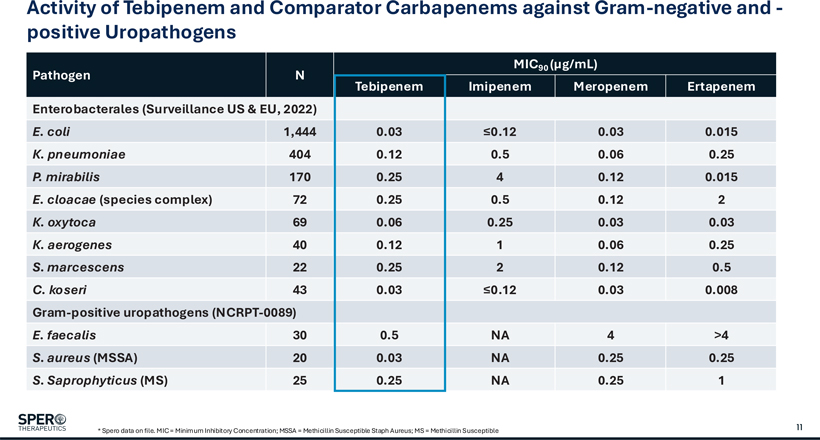
Activity of Tebipenem and Comparator Carbapenems against Gram-negative and -positive Uropathogens MIC90 (μg/mL) Pathogen N Tebipenem Imipenem Meropenem Ertapenem Enterobacterales (Surveillance US & EU, 2022) E. coli 1,444 0.03 ≤0.12 0.03 0.015 K. pneumoniae 404 0.12 0.5 0.06 0.25 P. mirabilis 170 0.25 4 0.12 0.015 E. cloacae (species complex) 72 0.25 0.5 0.12 2 K. oxytoca 69 0.06 0.25 0.03 0.03 K. aerogenes 40 0.12 1 0.06 0.25 S. marcescens 22 0.25 2 0.12 0.5 C. koseri 43 0.03 ≤0.12 0.03 0.008 Gram-positive uropathogens (NCRPT-0089) E. faecalis 30 0.5 NA 4 >4 S. aureus (MSSA) 20 0.03 NA 0.25 0.25 S. Saprophyticus (MS) 25 0.25 NA 0.25 1 * Spero data on file. MIC = Minimum Inhibitory Concentration; MSSA = Methicillin Susceptible Staph Aureus; MS = Methicillin Susceptible 11
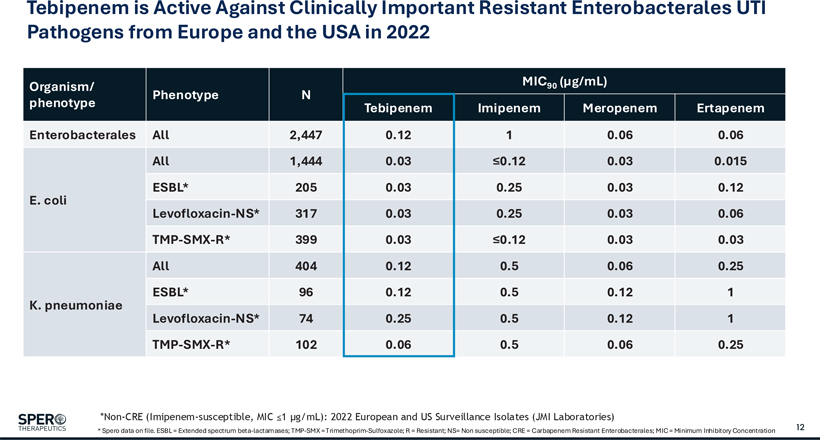
Tebipenem is Active Against Clinically Important Resistant Enterobacterales UTI Pathogens from Europe and the USA in 2022 Organism/ MIC90 (μg/mL) Phenotype N phenotype Tebipenem Imipenem Meropenem Ertapenem Enterobacterales All 2,447 0.12 1 0.06 0.06 All 1,444 0.03 ≤0.12 0.03 0.015 E. coli ESBL* 205 0.03 0.25 0.03 0.12 Levofloxacin-NS* 317 0.03 0.25 0.03 0.06 TMP-SMX-R* 399 0.03 ≤0.12 0.03 0.03 All 404 0.12 0.5 0.06 0.25 K. pneumoniae ESBL* 96 0.12 0.5 0.12 1 Levofloxacin-NS* 74 0.25 0.5 0.12 1 TMP-SMX-R* 102 0.06 0.5 0.06 0.25 *Non-CRE (Imipenem-susceptible, MIC ≤1 μg/mL): 2022 European and US Surveillance Isolates (JMI Laboratories) * Spero data on file. ESBL = Extended spectrum beta-lactamases; TMP-SMX = Trimethoprim-Sulfoxazole; R = Resistant; NS= Non susceptible; CRE = Carbapenem Resistant Enterobacterales; MIC = Minimum Inhibitory Concentration 12
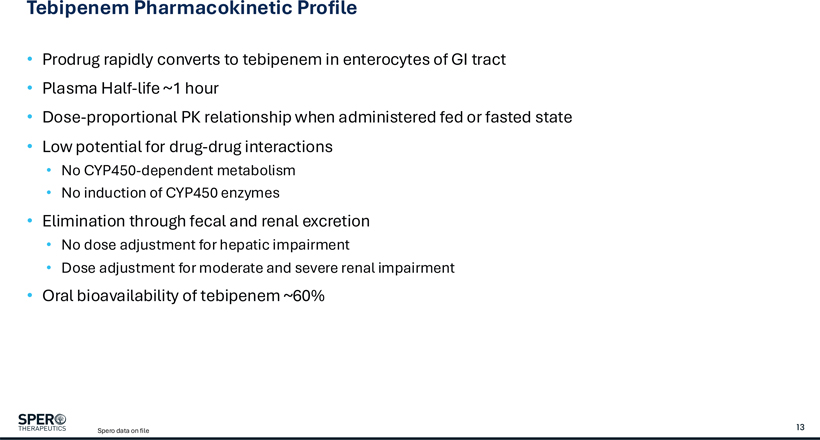
Tebipenem Pharmacokinetic Profile • Prodrug rapidly converts to tebipenem in enterocytes of GI tract • Plasma Half-life ~1 hour • Dose-proportional PK relationship when administered fed or fasted state • Low potential for drug-drug interactions • No CYP450-dependent metabolism • No induction of CYP450 enzymes • Elimination through fecal and renal excretion • No dose adjustment for hepatic impairment • Dose adjustment for moderate and severe renal impairment • Oral bioavailability of tebipenem ~60%
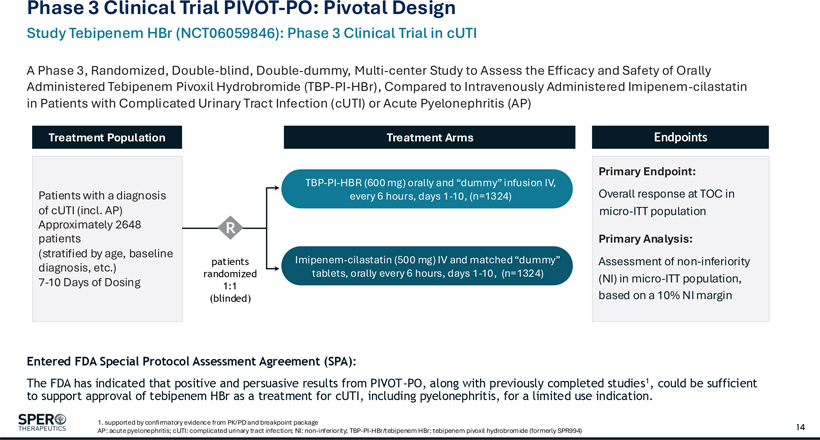
Phase 3 Clinical Trial PIVOT-PO: Pivotal Design Study Tebipenem HBr (NCT06059846): Phase 3 Clinical Trial in cUTI A Phase 3, Randomized, Double-blind, Double-dummy, Multi-center Study to Assess the Efficacy and Safety of Orally Administered Tebipenem Pivoxil Hydrobromide (TBP-PI-HBr), Compared to Intravenously Administered Imipenem-cilastatin in Patients with Complicated Urinary Tract Infection (cUTI) or Acute Pyelonephritis (AP) Treatment Population Treatment Arms Endpoints Primary Endpoint: TBP-PI-HBR (600 mg) orally and “dummy” infusion IV, Overall response at TOC in Patients with a diagnosis every 6 hours, days 1-10, (n=1324) of cUTI (incl. AP) micro-ITT population Approximately 2648 R patients Primary Analysis: (stratified by age, baseline patients Imipenem-cilastatin (500 mg) IV and matched “dummy” Assessment of non-inferiority diagnosis, etc.) randomized tablets, orally every 6 hours, days 1-10, (n=1324) (NI) in micro-ITT population, 7-10 Days of Dosing 1:1 (blinded) based on a 10% NI margin Entered FDA Special Protocol Assessment Agreement (SPA): The FDA has indicated that positive and persuasive results from PIVOT-PO, along with previously completed studies1, could be sufficient to support approval of tebipenem HBr as a treatment for cUTI, including pyelonephritis, for a limited use indication. 1. supported by confirmatory evidence from PK/PD and breakpoint package AP: acute pyelonephritis; cUTI: complicated urinary tract infection; NI: non-inferiority; TBP-PI-HBr/tebipenem HBr: tebipenem pivoxil hydrobromide (formerly SPR994) 14
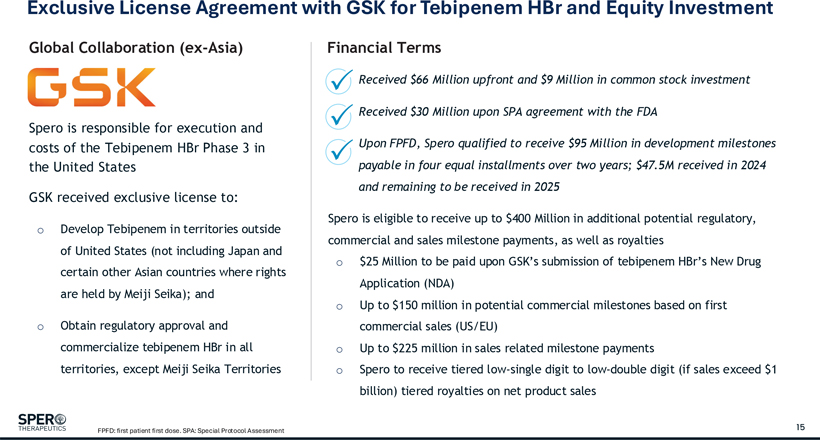
Exclusive License Agreement with GSK for Tebipenem HBr and Equity Investment Global Collaboration (ex-Asia) Financial Terms Received $66 Million upfront and $9 Million in common stock investment Received $30 Million upon SPA agreement with the FDA Spero is responsible for execution and costs of the Tebipenem HBr Phase 3 in Upon FPFD, Spero qualified to receive $95 Million in development milestones the United States payable in four equal installments over two years; $47.5M received in 2024 and remaining to be received in 2025 GSK received exclusive license to: Spero is eligible to receive up to $400 Million in additional potential regulatory, o Develop Tebipenem in territories outside commercial and sales milestone payments, as well as royalties of United States (not including Japan and o $25 Million to be paid upon GSK’s submission of tebipenem HBr’s New Drug certain other Asian countries where rights Application (NDA) are held by Meiji Seika); and Up in potential commercial o to $150 million milestones based on first o Obtain regulatory approval and commercial sales (US/EU) commercialize tebipenem HBr in all o Up to $225 million in sales related milestone payments territories, except Meiji Seika Territories o Spero to receive tiered low-single digit to low-double digit (if sales exceed $1 billion) tiered royalties on net product sales
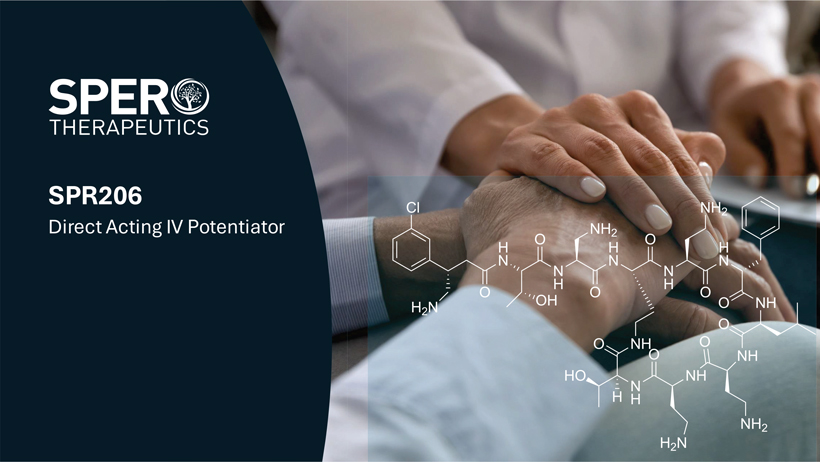
SPR206 Direct Acting IV Potentiator
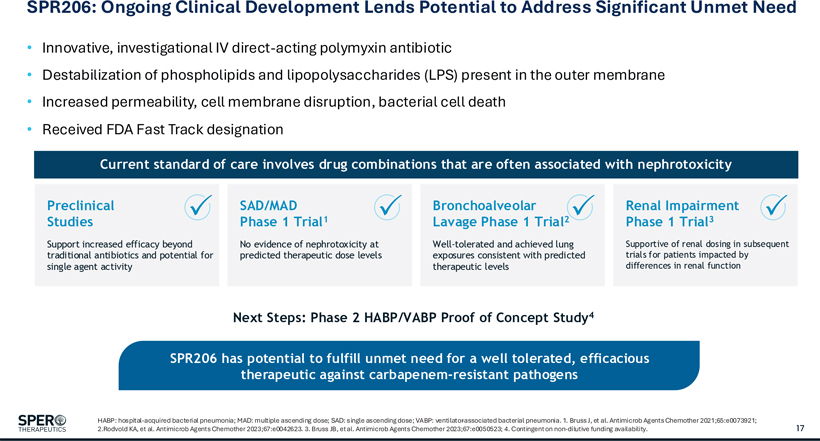
SPR206: Ongoing Clinical Development Lends Potential to Address Significant Unmet Need • Innovative, investigational IV direct-acting polymyxin antibiotic • Destabilization of phospholipids and lipopolysaccharides (LPS) present in the outer membrane • Increased permeability, cell membrane disruption, bacterial cell death • Received FDA Fast Track designation Current standard of care involves drug combinations that are often associated with nephrotoxicity Preclinical SAD/MAD Bronchoalveolar Renal Impairment Studies Phase 1 Trial1 Lavage Phase 1 Trial2 Phase 1 Trial3 Support increased efficacy beyond No evidence of nephrotoxicity at Well-tolerated and achieved lung Supportive of renal dosing in subsequent traditional antibiotics and potential for predicted therapeutic dose levels exposures consistent with predicted trials for patients impacted by single agent activity therapeutic levels differences in renal function Next Steps: Phase 2 HABP/VABP Proof of Concept Study4 SPR206 has potential to fulfill unmet need for a well tolerated, efficacious therapeutic against carbapenem-resistant pathogens HABP: hospital-acquired bacterial pneumonia; MAD: multiple ascending dose; SAD: single ascending dose; VABP: ventilator -associated bacterial pneumonia. 1. Bruss J, et al. Antimicrob Agents Chemother 2021;65:e0073921; 2.Rodvold KA, et al. Antimicrob Agents Chemother 2023;67:e0042623. 3. Bruss JB, et al. Antimicrob Agents Chemother 2023;67:e0050523; 4. Contingent on non-dilutive funding availability. 17
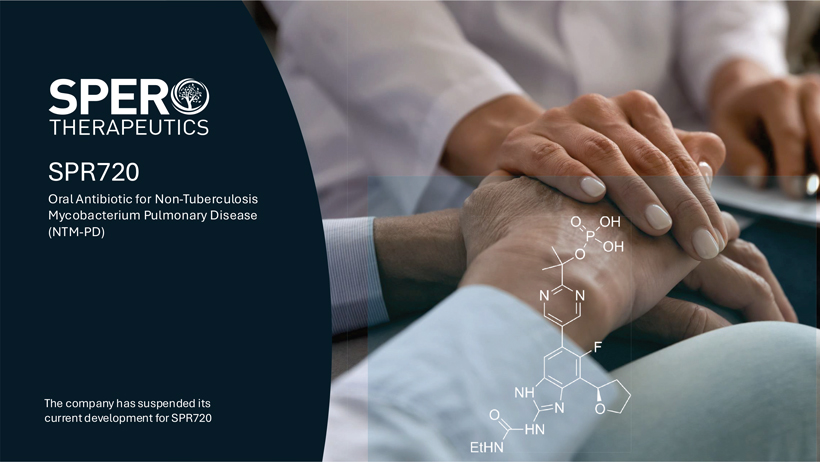
SPR720 Oral Antibiotic for Non-Tuberculosis Mycobacterium Pulmonary Disease (NTM-PD) The company has suspended its current development for SPR720
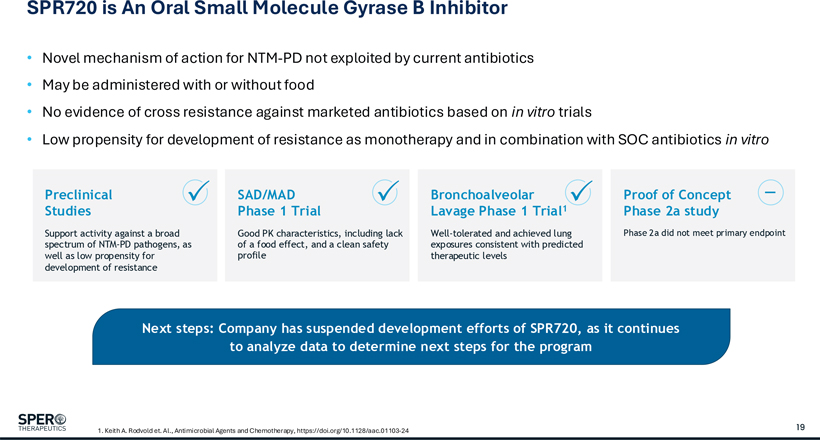
SPR720 is An Oral Small Molecule Gyrase B Inhibitor • Novel mechanism of action for NTM-PD not exploited by current antibiotics • May be administered with or without food • No evidence of cross resistance against marketed antibiotics based on in vitro trials • Low propensity for development of resistance as monotherapy and in combination with SOC antibiotics in vitro Preclinical SAD/MAD Bronchoalveolar Proof of Concept Studies Phase 1 Trial Lavage Phase 1 Trial1 Phase 2a study Support activity against a broad Good PK characteristics, including lack Well-tolerated and achieved lung Phase 2a did not meet primary endpoint spectrum of NTM-PD pathogens, as of a food effect, and a clean safety exposures consistent with predicted well as low propensity for profile therapeutic levels development of resistance Next steps: Company has suspended development efforts of SPR720, as it continues to analyze data to determine next steps for the program 1. Keith A. Rodvold et. Al., Antimicrobial Agents and Chemotherapy, https://doi.org/10.1128/aac.01103-24 19
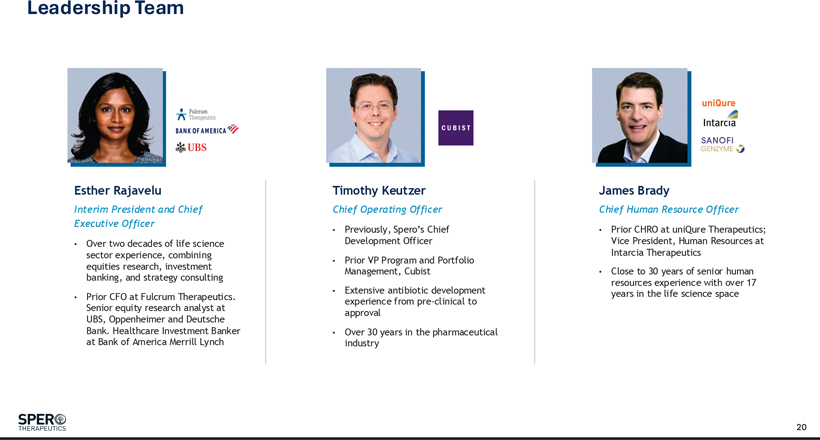
Leadership Team Esther Rajavelu Timothy Keutzer James Brady Interim President and Chief Chief Operating Officer Chief Human Resource Officer Executive Officer • Previously, Spero’s Chief • Prior CHRO at uniQure Therapeutics; • Over two decades of life science Development Officer Vice President, Human Resources at sector experience, combining Intarcia Therapeutics • Prior VP Program and Portfolio equities research, investment Management, Cubist • Close to 30 years of senior human banking, and strategy consulting resources experience with over 17 • Extensive antibiotic development years in the life science space • Prior CFO at Fulcrum Therapeutics. experience from pre-clinical to Senior equity research analyst at approval UBS, Oppenheimer and Deutsche Bank. Healthcare Investment Banker • Over 30 years in the pharmaceutical at Bank of America Merrill Lynch industry

Thank You